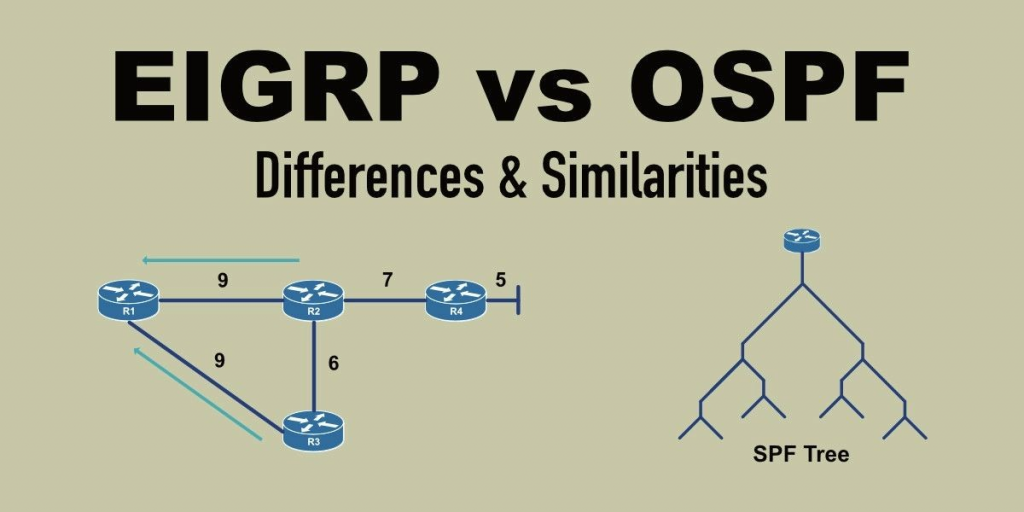
Deciding on the precise dynamic routing protocol is a core architectural choice on your enterprise community. Whereas each OSPF and EIGRP are broadly used Inside Gateway Protocols (IGPs), their design philosophies, operational behaviors, and scalability issues differ considerably.
This deep dive will allow you to perceive when to choose OSPF vs EIGRP, how every protocol operates, and sensible deployment issues to construct resilient, scalable, and environment friendly networks.
1. What Are OSPF and EIGRP?
OSPF (Open Shortest Path First) is a link-state routing protocol standardized by IETF. It makes use of Dijkstra’s SPF algorithm to calculate the shortest paths and helps hierarchical area-based designs, making it excellent for big, multi-vendor environments requiring structured scalability.
EIGRP (Enhanced Inside Gateway Routing Protocol) is a hybrid protocol, mixing distance-vector and link-state options. Identified for quick convergence and environment friendly useful resource utilization, EIGRP makes use of the DUAL algorithm and helps unequal-cost load balancing, which is useful for Cisco-centric environments.
2. How OSPF Works: Protocol Design and Structure
- Hyperlink-State Ads (LSAs): Routers alternate LSAs to construct a constant topology database inside an space.
- Dijkstra’s SPF Algorithm: Calculates the shortest path tree for environment friendly routing.
- Space-Primarily based Hierarchy:
- Space 0 (Spine): Obligatory central hub.
- Different areas hook up with Space 0, lowering flooding scope and database dimension.
- Equal-Price Multipath (ECMP): Helps a number of paths with the identical price for load balancing.
- Best For: Massive, complicated networks requiring fine-grained management and vendor interoperability.
3. How EIGRP Works: Protocol Design and Structure
- DUAL Algorithm: Allows speedy convergence and loop-free backup path choice.
- Partial and Incremental Updates: Sends updates solely on modifications, conserving bandwidth and CPU.
- Helps Unequal-Price Load Balancing: Maximizes hyperlink utilization throughout completely different speeds.
- Flat Community Topology: No express areas however can run a number of processes for segmentation.
- Best For: Cisco environments needing quick convergence and easier preliminary configurations.
4. Key Variations Between OSPF and EIGRP
| Characteristic | OSPF | EIGRP |
|---|---|---|
| Protocol Kind | Hyperlink-State | Hybrid |
| Algorithm | Dijkstra’s SPF | DUAL |
| Vendor Help | Multi-vendor | Primarily Cisco |
| Community Hierarchy | Space-based | Flat (multi-process doable) |
| Load Balancing | Equal-cost solely | Unequal-cost supported |
| Convergence Velocity | Quick | Very Quick |
| Useful resource Utilization | Increased CPU and reminiscence utilization | Decrease CPU and reminiscence utilization |
5. Efficiency and Convergence Comparability
- Each protocols provide quick convergence, however:
- EIGRP typically converges sooner attributable to possible successors and DUAL.
- OSPF recalculates the SPF tree, which might require extra CPU on giant topologies.
- EIGRP’s partial updates scale back overhead, whereas OSPF’s periodic SPF recalculation can eat extra sources.
6. Actual-World Deployment Eventualities
OSPF is advisable for:
- Multi-vendor environments.
- Massive campus and knowledge heart networks.
- Networks requiring hierarchical segmentation for scalability and clear administrative boundaries.
EIGRP is advisable for:
- Cisco-centric infrastructures.
- Networks leveraging numerous WAN hyperlinks requiring unequal-cost load balancing.
- Environments prioritizing speedy failover and decrease configuration complexity for preliminary deployments.
7. Migration Issues: EIGRP to OSPF
- Route Redistribution: Stop routing loops with correct filtering.
- Metric Translation: Perceive how EIGRP metrics map to OSPF prices.
- Gradual Migration: Run each protocols throughout migration and monitor stability.
Tip: Use route tagging throughout redistribution to establish and handle discovered routes effectively.
8. Selecting the Proper Protocol for Your Community
- Vendor Technique: OSPF for multi-vendor; EIGRP for Cisco.
- Scalability Wants: OSPF for extremely scalable, segmented networks.
- Convergence Priorities: EIGRP for the quickest convergence.
- Load Balancing Necessities: EIGRP if unequal-cost load balancing is important.
- Useful resource Constraints: EIGRP for routers with restricted CPU and reminiscence.
In case your atmosphere evolves towards SD-WAN or requires multi-vendor integration, OSPF will typically be a extra future-proof alternative.
9. Conclusion
Each OSPF and EIGRP are strong and confirmed routing protocols. Your alternative ought to align together with your current infrastructure, future scalability objectives, and the experience of your community workforce. There isn’t any common “greatest.” Strategic protocol choice helps guarantee your community stays secure, scalable, and prepared for development.
For fast reference and direct comparisons, see our FAQ: What’s the Difference between OSPF vs EIGRP.
👇Observe extra 👇
👉 bdphone.com
👉 ultractivation.com
👉 trainingreferral.com
👉 shaplafood.com
👉 bangladeshi.help
👉 www.forexdhaka.com
👉 uncommunication.com
👉 ultra-sim.com
👉 forexdhaka.com
👉 ultrafxfund.com
👉 bdphoneonline.com
👉 dailyadvice.us


